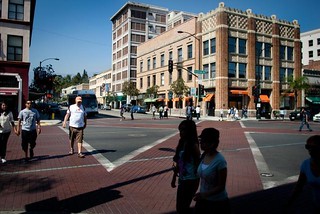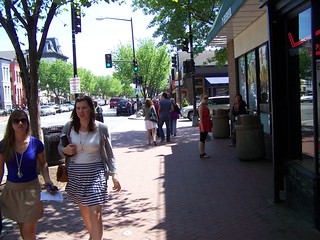Historic preservation and communities as a long term sustainable revitalization strategy
Tomorrow is the first of May which starts National Historic Preservation Month, which is designed to raise attention about the value of historic preservation in a variety of ways--not only for urban revitalization.
 Gina Ferazzi / Los Angeles Times. Pedestrians cross at Colorado Boulevard and Raymond Avenue in revitalized Old Pasadena. Thirty years ago it was seedy, but today restored buildings radiate charm.
Gina Ferazzi / Los Angeles Times. Pedestrians cross at Colorado Boulevard and Raymond Avenue in revitalized Old Pasadena. Thirty years ago it was seedy, but today restored buildings radiate charm.Last weekend, there was a travel story ("The new Old Pasadena may just bowl you over") in the Sacramento Bee about Old Pasadena, the historically designated historic district in Pasadena, California, which is now a reasonably well thriving commercial district, with housing, a great deal of successful retail and entertainment options, etc.
(UCLA Professor Donald Shoup would also argue that part of the success of this district has to do with his pioneering work there with regard to parking policies, e.g., "Turning Small Change Into Big Changes," Access Magazine, University of California).
On the other hand, there is a piece in the Capitol Hill Corner blog, "On the Eve of Potbelly’s Arrival on Barracks Row, Is Capitol Hill Losing It’s Character?," that opines that Capitol Hill residents want more retail, but instead they are getting more restaurants, and chain outlets such as Potbelly.

Barracks Row Main Street, 8th Street SE, Capitol Hill.
This is a tricky issue.
As we can see, while historic preservation is key to "saving" urban neighborhoods, as Capitol Hill in DC is also a historic district and has been since the mid-1970s, just because your community is historically designated doesn't mean that it can be a successful retail district--even if it is successful for restaurants.
With regard to local retail, it's becoming much more difficult for non-convenience retail to subsist or thrive at the level below what we would consider a regional shopping district, especially in categories like apparel, housewares and home goods, and sporting goods. (The main convenience retail categories are groceries, hardware, pharmacy and gasoline for cars.)
Pasadena's Old Pasadena district is the main shopping district for the city and is a regional destination for residents and visitors, while Capitol Hill is a destination for visitors but not so much for its retail offer.
While Pasadena too competes with other locations for retail businesses and customers, it's in a much bigger region (the city is 1/3 the size of DC with about 1/4 of the population of DC).
The Capitol Hill commercial district competes (unsuccessfully) with Georgetown, Friendship Heights, and to some extent Connecticut Avenue-Dupont Circle as a retail district, as well as with suburban locations. And it's getting a renewed even H Street, as it gets streetcar service is likely to reposition as more of a retail district, as it adds anchors like Whole Foods Supermarket.
That being said, destination retailers can be developed but they will require extranormal responses by commercial districts and residents.
For example, a bookstore may be opening in DC's Georgetown retail district and in order to do so it is getting funding from the commercial district improvement group and residents ("Politics & Prose Bookstore Is Considering Opening a Second Location," Washingtonian Magazine).
And DC has expanded its retail and restaurant support program, which is another source that can be tapped for financing ("D.C.'s Great Streets Grant Program Helps Fund Restaurants and Bars," Washington City Paper), even if some are critical.
 Capitol Hill neighborhood brand/mural in Seattle.
Capitol Hill neighborhood brand/mural in Seattle.But it helps to start with a plan. For a number of years, I've suggested ("Neighborhoods and commercial districts as brands") the creation of a Capitol Hill destination development, management, and marketing plan, which they don't have.
Labels: commercial district revitalization planning, formula retail, historic preservation, urban design/placemaking, urban revitalization



5 Comments:
again- it is the emphasis on turing mixed use buildings into strictly residential that has doomed capitol Hill's retain possibilities. Yes- in the 60's , 70's & 80's even into the 90's some of the old mom & pop stores seemed to encourage loiterers or crime nearby but this was more due to the declining city than the idea of having nearby stores. I can still recall as a kid seeing many many more corner stores with a whole array of offerrings. Now it is a desert and most people drive other places to shop- they get in their cars and drive and the city loses money. We have plenty of population to make the corner stores work we just have laggard policies and resistance from old timers afraid of change even if it is more historically accurate to have corner stores than not.
corner stores are a very limited slice of the market and in fact, Capitol Hill probably has more successful corner stores than any other part of the city.
3rd and F St. NE; 7th and F St. NE, 4th and E. Capitol NE, 5th and E. Capitol SE, Lincoln Park, 2nd and E SE? come to mind right off, and I believe that there are a number of others.
2. It's the broader range of retail. To get it and survive locally, there needs to be a lot of population.
I know that NYC "isn't" a good example, but e.g., Astoria has many shopping streets and the Steinway Street commercial district and it has a big population. According to Wikipedia it's a pop. of 154,000. The retail isn't hoity toity/pretty, it's shoe stores like Payless and independents and stores like Claires, but it is retail and it's in the neighborhood.
as I see it - the policies and NIMBYs hold up more retail on CH. These are the people afraid of any changes at all- those that seek to keep density way down. I am in favor of much more density- such as there was around WW2 and after when the city was at its height. We can fit the population in here but they all cannot own cars- this is for certain.
no matter what - policies should not stand int he way of any attempt to make small retail work or for new versions of mom & pop retail to re-appear- and I am also for the retention of mixed use when a structure is sold- turning it exclusively into a house should not be permitted in certain instances. I hear nothing but complaints about lack of stores of any kind in the eastern parts of CH whereas at one time there were numerous stores - small general stores and that kind of thing. I say let it happen and do not hold it back. It can only make life better if small retail is allowed. As it stands now- anytime someone wants to open a small store they are held back by numerous hurdles- high rents, high taxes on small business, and resistance from HP and other beholden or NIMBY groups that fear changes. Just create the atmosphere for it and see what the market forces do. It couldnt hurt ...
Something that I didn't mention from the CHC article that I thought was an interesting supposition. He suggested that restaurants are subsidized business-wise because they are allowed to pay lower wages to tipped employees, and this privileges restaurants vs. retail.
I think that's an interesting point. It wouldn't make any difference though if they just raised their prices and didn't allowing tipping.
More importantly, the average restaurant likely has upwards of 10 times more employees than a typical retail store, especially a small, independently owned retail store.
That was a point he missed.
Post a Comment
<< Home